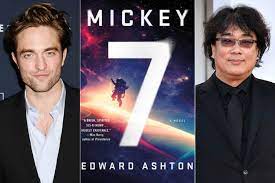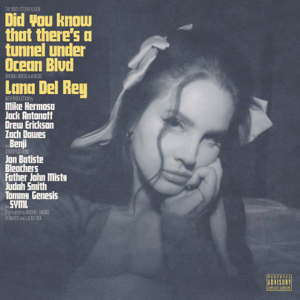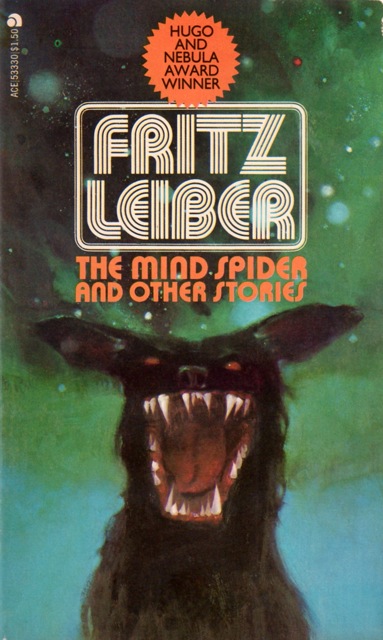
MEMORIAL DAY 2023



On a distant planet a human colony is struggling to survive with a colder than predicted climate and problems growing food. They are down to 175 people (although they have many embryos ready…if the colony gets established). One of the 175 people is hot-shot pilot named Berto who is being questioned about an incident by the head of the colony, Marshall. Here’s part of the interview:
“Primarily that the Security officers involved were upset about the consequences of their own poor judgement, and one of them decided to work out his frustrations by assaulting an innocent bystander.”
“Huh,” Marshall says. “Mr. Drake assaulted you? How is it then, that he’s in Medical with a cracked zygomatic arch, while you appear to be completely uninjured?”
Berto shrugs. “I said he assaulted me. I didn’t say he did a good job of it.” (p. 169)
If you enjoy this kind if flippant repartee, then you’re likely to enjoy Edward Ashton’s Mickey 7. Ashton invents a future where human personalities can be stored and then reinserted into bio-3D printed bodies. This technology is used to provide a Mission Expendable–in this case Mickey 7–who does the serious and deadly work for the colony necessary for it to exist. And, this Mickey Barnes has died six times and has been regenerated for a 7th time.
Mickey 7 encounters a giant alien centipede on a mission outside the colony dome. Berto, the pilot who was providing air support, reports Mickey 7 has died…but doesn’t see that the giant alien centipede returns Mickey 7 to the dome unhurt. With the report that Mickey 7 has died, the Lab regenerates a Mickey 8. That becomes the focus of the novel with both funny and moving moments as the two Mickeys have to resolve their differences and keep their secrets while trying to stay alive from Marshall’s distaste for Expendables.
Mickey 7 is currently in production as a feature film. I’ll go see it! GRADE: B+

James Geary’s I Is an Other (2011) explores metaphors and how they work (or don’t work). Here are some examples of metaphors that don’t work:
“She grew on him like she was a colony of E. coli and he was room temperature Canadian beef.” (p. 144)
“He was deeply in love. When she spoke, he thought he heard bells, as if she were a garbage truck backing up.” (p. 144)
Geary explains what makes metaphors work effectively. A metaphor activates two thoughts of two different things at the same time. To illustrate how this works, Geary resorts to one of my favorite Star Trek episodes:
“This same lack of essential context is what perplexed the crew of the Starship Enterprise when they encountered the Tamarians in the ‘Darmok’ episode of Star Trek: The Next Generation. The Tamarians speak a language no one has yet been able to fully decipher. The Tarmarian tongue is so elusive because it is so allusive, consisting entirely of kennings from the alien race’s mythology and history.” (p. 162) That is, the Tamarians speak in metaphors. In comprehending metaphor, context is king. Once the crew of the Enterprise figure out the context of the Tamarians, they cracked the language code.
I enjoy James Geary’s breezy books on metaphors, aphorisms, and wit. Highly recommended! GRADE: A
TABLE OF CONTENTS:
Foreword: Why I is an Other p. 1
Metaphor and Thought: All Shook Up p. 5
Metaphor and Etymology: Language is Fossil Poetry p. 17
Metaphor and Money: How High Can a Dead Cat Bounce? p. 29
Metaphor and the Mind: Imagining an Apple in Someone’s Eye p. 44
Metaphor and Advertising: Imaginary Gardens with Real Toads in Them p. 58
Metaphor and the Brain: Bright Sneezes and Loud Sunlight p. 76
Metaphor and the Body: Anger is a Heated Fluid in a Container p. 94
Metaphor and Politics: Freedom Fries and Liberty Cabbage p. 112
Metaphor and Pleasure: Experience is a Comb That Nature Gives to Bald Men p. 137
Metaphor and Children: How Should One Refer to the Sky? p. 152
Metaphor and Science: The Earth is Like a Rice Pudding p. 167
Metaphor and Parables and Proverbs: Mighty Darn Good Lies p. 179
Metaphor and Innovation: Make it Strange p. 197
Metaphor and Psychology: A Little Splash of Color From My Mother p. 208
Backword: The Logic of Metaphor p. 223
Acknowledgments p. 227
Notes p. 229
Bibliography p. 259
Index p. 291


I’ve enjoyed Elizabeth Hardwick’s essays over the years so this new collection of Hardwick’s more obscure essays caused me to rejoice! Take “On Reading the Writings of Women” for example. I’m always intrigued by writer’s opinions of other writers. Hardwick writes, “I found the English novelist Iris Murdoch’s book The Bell nearly unreadable. It seemed to me slow, unreal, with a superabundance of symbolic action that dulled the edge of the inspiration.” (p. 223-224).
While Hardwick wasn’t impressed by Murdoch’s work, she did read Doris Lessing’s books and raved: “These books are all superb–the works of a woman with an extraordinary gift for fiction.” (p. 224)
Many of these pieces originally were published in magazines which reflects both the content and the writing style. “Faye Dunaway” shows Hardwick’s knowledge of movies and how they display societal issues. Hardwick can also be nerdy in articles like “Knowing Sontag” and “Balanchine.”
The weakest articles–simply because they’re dated–are the political pieces. Does anyone remember the Kennedy scandals beyond Chapppaquiddick? Hardwick provides plenty of evidence that all the Kennedy men trifled with women not their wives.
If you’re looking for intelligent commentary on social, literary, cultural, and political issues, The Uncollected Essays of Elizabeth Hardwick provides plenty to think about. GRADE: B+
TABLE OF CONTENTS:
Introduction vii
The Art of the Essay 1
Places, People, Things
New York City: Crash Course 13
Lexington, Kentucky 24
Puritanical Pleasures 37
The Émigré 47
Balanchine 54
Faye Dunaway 59
Knowing Sontag 65
Katherine Anne 68
Things 77
Piety and Politics
Elections 87
Mr. America 90
Piety and Politics 97
The Kennedy Scandals 106
The Menendez Show 122
Family Values 139
Head Over Heels 155
On Behalf of the Unborn 167
Feminine Principle
The American Woman as Snow Queen 171
The Feminine Principle 180
Women Re Women 189
The Ties Women Cannot Shake, and Have 196
Is the “Equal” Woman More Vulnerable? 200
Suicide and Women 206
When to Cast Out, Give Up, Let Go 213
Readings
On Reading the Writings of Women 223
Reading 229
Southern Literature: The Cultural Assumptions of Regionalism 236
Musings
Basic Englishing 251
Parsifal 255
The Eternal Heartbreak 257
The Heart of the Seasons 263
Notes on Leonardo and the Future of the Past 270
Grits Soufflé 276
Christmas Past 278
Acknowledgments 280
Sources 281

I spent most of last week listening to new music CDs. The two I enjoyed the most are Jessie Ware’s That Feels Good! and Lana Del Rey’s There’s a Tunnel Under Ocean Blvd.
As the review in the Wall Street Journal says: “The title track on Jessie Ware’s That Feels Good! launches with a clear statement of purpose as friends of Ms. Ware, including Kylie Minogue and Róisín Murphy, whisper the titular phrase repeatedly just before the irresistible beat kicks in. Its groove, powered by a rubbery bassline and surging horns, is a marvel of arrangement—there’s a great deal going on, but the track also feels infectiously light and spacious. And then the following “Free Yourself” adds a hypnotic piano and shouted background vocals to the body-moving mix, while the third track, “Pearls,” combines the force and confidence of Chaka Khan’s “I’m Every Woman” with the warmth of Donna Summer.” I agree.
I was blown away in 2019 by Lana Del Rey’s “Norman F—ing Rockwell!” It created a world of sound and music that kept me listening to it for weeks. Now Did You Know That There’s a Tunnel Under Ocean Blvd arrives with the same level of energy and wonder. This is Lana Del Rey’s 9th album and should rank near the top in quality. She also involves a talented team to boost her music: her frequent partner Jack Antonoff makes many contributions, and Drew Erickson and Zach Dawes, both of whom have worked with Ms. Del Rey on previous albums, appear here on multiple tracks—often to fold in dreamy strings, evoking the billowy arrangements favored by Natalie Mering of Weyes Blood.
If you’re in the mood for some marvelous music miles away from contemporary radio bilge, here are two winners! GRADE: A (for both)
TRACK LIST:
| That! Feels Good! | 4:22 | ||
| Free Yourself | 3:54 | ||
| Pearls | 4:03 | ||
| Hello Love | 4:42 | ||
| Begin Again | 5:24 | ||
| Beautiful People | 3:35 | ||
| Freak Me Now | 3:28 | ||
| Shake The Bottle | 3:23 | ||
| Lightning | 3:10 | ||
| These Lips | 4:21 |

TRACK LIST:
| The Grants | ||
| A2 | Did You Know That There’s A Tunnel Under Ocean Blvd | |
| A3 | Sweet | |
| A4 | A&W | |
| B1 | Judah Smith Interlude | |
| B2 | Candy NecklaceFeaturing – Jon Batiste Featuring – Jon Batiste | |
| B3 | Jon Batiste Interlude | |
| B4 | Kintsugi | |
| C1 | Fingertips | |
| C2 | Paris, TexasFeaturing – SYML Featuring – SYML | |
| C3 | Grandfather Please Stand On The Shoulders Of My Father While He’s Deep-Sea Fishing | |
| C4 | Let The Light InFeaturing – Father John Misty Featuring – Father John Misty | |
| D1 | MargaretFeaturing – BleachersF eaturing – Bleachers | |
| D2 | Fishtail | |
| D3 | PeppersFeaturing – Tommy Genesis Featuring – Tommy Genesis | |
| D4 | Taco Truck x VB |

I became a Fritz Leiber fan when I read his classic SF novel, The Big Time (1958). It was awarded the Hugo Award for Best Novelette. The Big Time was published originally in two parts in Galaxy Magazine‘s March and April 1958 issues, illustrated by Virgil Finlay. Then ACE Books published The Big Time and The Mind Spider and Other Stories as ACE Double D-491.
Where The Big Time focuses on “The Change War” where two opposing factions use time travel to wage their conflict, some of Leiber’s short stories in The Mind Spider and Other Stories use elements of the Change War to propel their plots. Probably the most well known of these stories is “The Oldest Soldier” who shows how deadly the Change War can be. I enjoyed the mystery solving aspects of “The Number of the Beast” where a human policeman must solve a case involving alien telepaths. “Midnight in the Mirror World” is not a Change War story, but it has a haunting puzzle dealing with a mysterious Mirror World. I enjoy Fritz Leiber’s SF and fantasy novels, but he’s also adept at writing entertaining short stories. GRADE: B+
TABLE OF CONTENTS:

I became a fan of Donna Summer the first time I heard “Love to Love You, Baby,” where the final recording lasted over 16 minutes–and according to the BBC, contained 23 “orgasms”!
Love to Love You, Donna Summer, directed by Roger Ross Williams and Brooklyn Sudano, follows the life and career of Donna Summer. Williams and Sudano did not shy away from exploring difficult aspects of Summer’s life and career.
What makes this documentary different is that Sudano and Williams opted to use Summer speaking in her own words by using audiotapes recorded for her memoir Ordinary Girl (2003). Summer’s journey from singing in a Boston church to her unexpected reign as the Queen of Disco—and the tragedy and spiritual rebirth that followed–makes for a compelling story.
As a teenager, Donna Summer left the United States to join the German cast of Hair. She was still in her teens, a shy, ordinary girl who was suddenly feeling the jolt of the sexual revolution. She lived in Germany for seven and a half years, modeling, acting, falling in love, getting married, and giving birth to a daughter. She met a producer named Giorgio Moroder, and together they created a song called “Love to Love You Baby.” It became one of the world’s premier disco hits.
Donna Summer earned five Grammy Awards, three consecutive Number One platinum albums (she is the only artist, male or female, ever to have accomplished this), eleven gold albums, four Number One singles, two platinum singles, and twelve gold singles. Despite her musical success, Donna Summer’s life was rocky. Are you Donna Summer fan? GRADE: A

After reading David Lehman’s The Most Mysterious Romance of Murder (you can read my review here), I decided to go back and reread Lehman’s The Perfect Murder from 1989 (updated version 1999). I remembered I enjoyed The Perfect Murder over 30 years ago. I also remember this:
DAVID LEHMAN’S PERSONAL FAVORITES:
The Hound of the Baskervilles (1902) — Arthur Conan Doyle
Innocence of Father Brown (1911) — G. K. Chesterton
The Maltese Falcon (1930) — Dashiell Hammett
The Three Coffins (1936) — John Dickson Carr
The ABC Murders (1936) — Agatha Christie
Thou Shell of Death (1936) — Nicholas Blake
The Big Sleep (1939) — Raymond Chandler
A Coffin for Dimitrios (1939) — Eric Ambler
The Big Clock (1946) — Kenneth Fearing
Too Many Women (1947) — Rex Stout
The Eighth Circle (1958) — Stanley Ellin
The Chill (1964) — Ross Macdonald
Long Time No See (1978) — Ed McBain
The Name of the Rose (1983) — Umberto Eco
The Singing Detective (1986) — Dennis Potter
As well has providing a survey of detective fiction, Lehman gives his personal list of great mysteries. How many of these classics have you read? Any favorites? GRADE: A
TABLE OF CONTENTS:
| Preface to the New Edition | ix | ||
| Acknowledgments | xi | ||
| Introduction | xiii | ||
| The Corpse on Page One | 1 | (12) | |
| The Birth of a New Hero | 13 | (10) | |
| Mysteries and Myths | 23 | (14) | |
| Murder Considered as a Fine Art | 37 | (8) | |
| De Quincey’s Irony | 45 | (10) | |
| No Police Like Holmes | 55 | (16) | |
| The Legacy of Edgar Allan Poe | 71 | (12) | |
| No Mask Like Open Truth | 83 | (10) | |
| The Double | 93 | (8) | |
| Funerals in Eden | 101 | (16) | |
| From Paradise to Poisonville | 117 | (18) | |
| The Hard-boiled Romance | 135 | (20) | |
| Hammett and Chandler | 155 | (14) | |
| Ross MacDonald and After | 169 | (12) | |
| A Portrait of the Reader as Escapist | 181 | (16) | |
| At the Heart of the Maze | 197 | (14) | |
| Afterword: Shades among Shadows | 211 | (16) | |
| Appendix 1. Further Reading | 227 | (10) | |
| Appendix 2. Personal Favorites | 237 | (4) | |
| Notes | 241 | (10) | |
| Index of Concepts | 251 | (4) | |
| Index of Names and Titles | 255 |

Colonialism, imperialism, secrets, and mysticism collide in this magic-imbued meditation on the power of words, who wields it, and how translation can be as powerful a weapon as it is a tool. Winner of this year’s Nebula Award for Best Novel, R. F. Kuang’s arcane history of using language and translation as a dominating tool of the British Empire turns traditional history on its head.
Huang explores the evils of imperialism, student revolutions, the history of violence, and terrifying powers as Babel blends magic, lore, and cruelty into a compelling story.
Babel is both smart and witty while the aspects of Huang’s plot center around silver working—the art of manifesting the meaning lost in translation using enchanted silver bars—which has made the British unparalleled in power throughout the world as its knowledge serves the Empire’s quest for colonization.
If you’re in the mood for an Alternate History of the British Empire circa 1828, Babel presents a world ruled by the magic powers of translation…and treachery! GRADE: B

“For my mother… [it was] sidelong looks, people moving away from her in the post office or the grocery store; in the man who slapped her across the face while she was walking down the street in Denver her freshman year of college, screaming, ‘You dirty yellow thing, taking jobs away from good American people!'” (p. 101).
Natalie Hodges, whose mother immigrated to the United States from Seoul, Korea in 1966, struggles for assimilation in a hostile country. Natalie’s mother marries and has four children. All the children were encouraged to play musical instruments. Natalie gravitated to the violin at an early age and decided she wanted to be a solo violinist.
The odds of becoming a soloist in the current state of Classical Music is about the chances of making it to the National Football League as a starter. Natalie realizes her dreams would never come true, quits playing the violin, and tries to move on with her Life. But, Natalie returns to the violin and learns to enjoy music again.
My favorite chapter in Uncommon Measure is “Chaconne,” the Bach work that is considered the ultimate piece of music for the violin. Of course, it is incredibly difficult to play. This is Art Scott’s favorite piece of Classical Music. Natalie’s analysis of “Chaconne,” its background, and her trials trying to play the work dazzled me!
Uncommon Measure explores music, disappointment, loss, racism, and perseverance. Very inspiring! GRADE: B+
TABLE OF CONTENTS:
Prelude 13
Un trainmen 17
A Sixth Sense: Notes on Improvisation 46
Symmetry Breaking 79
Chaconne 111
The Still Point of the Turning World 141
Coda: Memory Is a Hologram 173
Acknowledgments 181
Credits 185
Notes 186
Bibliography 195